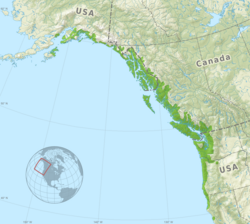Sitka Spruce
| Sitka spruce | |
|---|---|
 |
|
| Quinault Lake Spruce, the largest member of the species according to American Forest by points | |
| Scientific classification | |
| Kingdom: | Plantae |
| Division: | Pinophyta |
| Class: | Pinopsida |
| Order: | Pinales |
| Family: | Pinaceae |
| Genus: | Picea |
| Species: | P. sitchensis |
| Binomial name | |
|
Picea sitchensis (Bong.) Carr. |
|
 |
|
| Range highlighted in dark green | |
Picea sitchensis, the Sitka spruce, is a large, coniferous, evergreen tree growing to almost 100 m (330 ft) tall, and with a trunk diameter at breast height that can exceed 5 m (16 ft) (see List of superlative trees). It is by far the largest species of spruce and the fifth-largest conifer in the world (behind giant sequoia, coast redwood, kauri, and western redcedar); and the third-tallest conifer species (after coast redwood and coast Douglas-fir). The Sitka spruce is one of the few species documented to reach 91 m (299 ft) in height. Its name is derived from the community of Sitka, Alaska.
The bark is thin and scaly, flaking off in small, circular plates 5–20 cm (2.0–7.9 in) across. The crown is broad conic in young trees, becoming cylindric in older trees; old trees may not have branches lower than 30–40 m (98–131 ft). The shoots are very pale buff-brown, almost white, and glabrous (hairless), but with prominent pulvini. The leaves are stiff, sharp, and needle-like, 15–25 mm long, flattened in cross-section, dark glaucous blue-green above with two or three thin lines of stomata, and blue-white below with two dense bands of stomata.
The cones are pendulous, slender cylindrical, 6–10 cm (2.4–3.9 in) long and 2 cm broad when closed, opening to 3 cm broad. They have thin, flexible scales 15–20 mm long; the bracts just above the scales are the longest of any spruce, occasionally just exserted and visible on the closed cones. They are green or reddish, maturing pale brown 5–7 months after pollination. The seeds are black, 3 mm long, with a slender, 7–9 mm long pale brown wing.
...
Wikipedia

